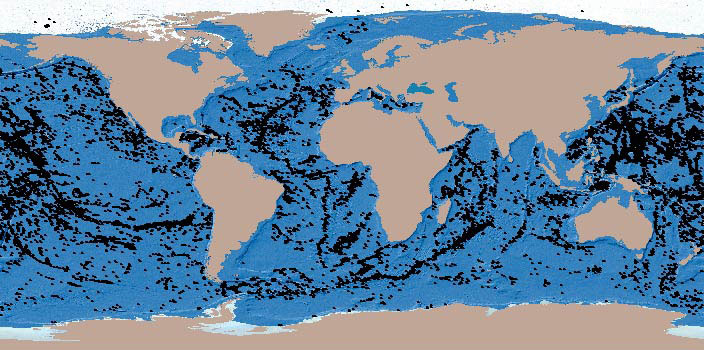Areas Beyond National Jurisdiction (ABNJ)

This dataset shows the global distribution of mangrove forests, derived from earth observation satellite imagery. The dataset was created using Global Land Survey (GLS) data and the Landsat archive. Approximately 1,000 Landsat scenes were interpreted using hybrid supervised and unsupervised digital image classification techniques. See Giri et al.
Recent revisions to the satellite-derived vertical gravity gradient (VGG) data reveal more detail of the ocean bottom and have allowed us to develop a non-linear inversion method to detect seamounts in VGG data. We approximate VGG anomalies over seamounts as sums of individual, partially overlapping, elliptical polynomial functions, which allows us to form a non-linear inverse problem by fitting the polynomial model to the observations.
Reefs at Risk Revisited brings together data on the world’s coral reefs in a global analysis designed to quantify threats and to map where reefs are at greatest risk of degradation or loss. We incorporated more than 50 data sources into the analysis—including data on bathymetry (ocean depth), land cover, population distribution and growth rate, observations of coral bleaching, and location of human infrastructure.
This dataset shows the known locations of sea turtle feeding sites, for five of the seven species: hawksbill turtle (Eretmochelys imbricata), leatherback turtle (Dermochelys coriacea), green turtle (Chelonia mydas), loggerhead turtle (Caretta caretta), and olive ridley turtle (Lepidochelys olivacea).
This dataset shows the known locations of sea turtle nesting sites, for all seven species: hawksbill turtle (Eretmochelys imbricata), Kemp’s ridley turtle (Lepidochelys kempii), leatherback turtle (Dermochelys coriacea), green turtle (Chelonia mydas), loggerhead turtle (Caretta caretta), olive ridley turtle (Lepidochelys olivacea), and flatback turtle (Natator depressus).
This dataset is no longer being maintained and must be used with caution.
- ‹ previous
- 1
- 2
- 3
- 4